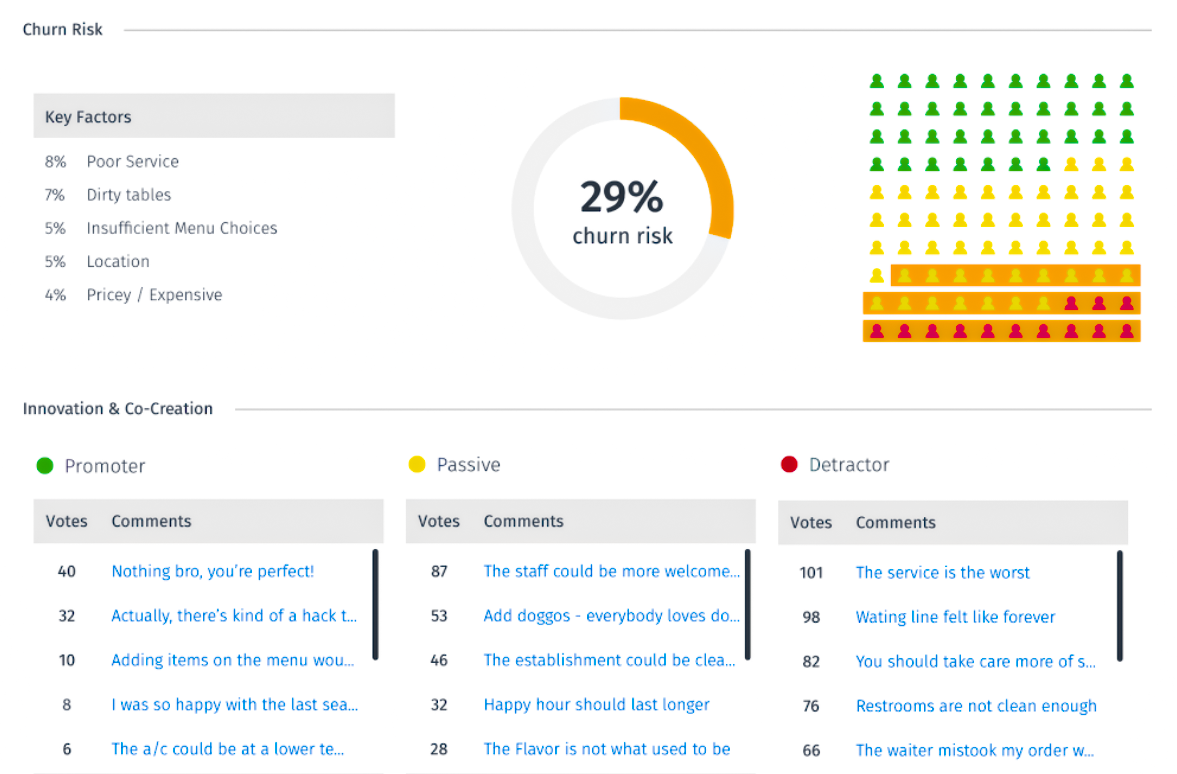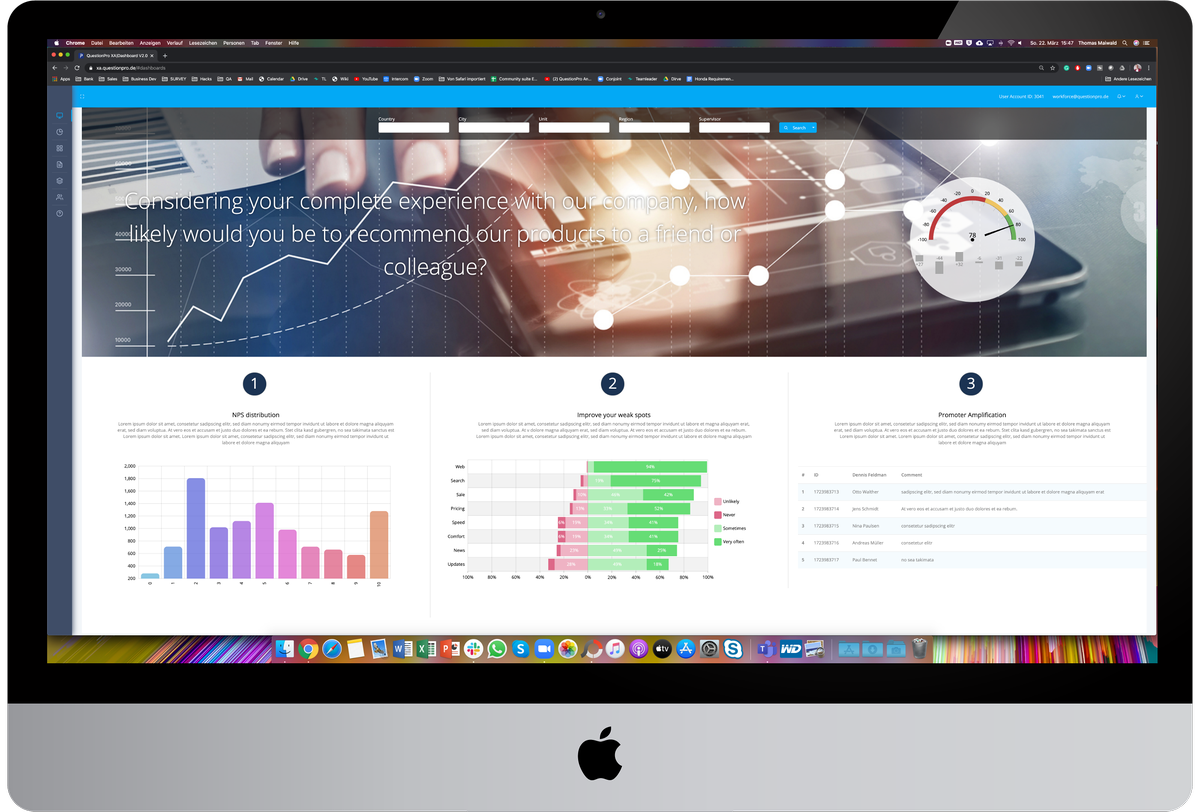Save The Date | Customer Experience Management Best Practices
Reputation steigern, Kundenabwanderung senken! Unter diesem Motto referieren Spezialisten aus den Bereichen Customer Experience Management und Marktforschung
Reputationsmanagement und Customer Churn Prediction
- 1 Best Practices anschaulich vermittelt
- 2 QuestionPro stellt neue Technologie für aktives Reputationsmanagement vor
- 3 Top-Thema des Zoom Meetings: Marketingforschung mit Maschinen UND Menschen: Was Neuroscience und Artificial Intelligence jetzt schon kann
- 4 Mit KI-basierter semantischer Textanalyse die eigene Reputation stets im Blick
- 5 Customer Churn Prediction: Mit dem Net Promoter Score Kundenabwanderung vorhersagen
- 6 JETZT VORAB ANMELDEN: Reputation steigern, Kundenabwanderung senken. Customer Experience Management Best Practices
- 7 Software für Reputationsmanagement und Customer Churn Prediction jetzt 10 Tage kostenlos testen!
Best Practices anschaulich vermittelt
QuestionPro, einer der weltweit bedeutendsten Anbieter von Technologien für Enterprise Feedback Management, Customer Experience Management und Marktforschung, veranstaltet am Dienstag, den 17. November 2020 ab 10:30 Uhr ein Live Zoom-Meeting zu den Themen Reputationsmanagement und Customer Churn Prediction. Hierbei referieren Consulting-Spezialisten, erfahrene Praktiker sowie Market Research Analysten zu zwei der wichtigsten Themen innerhalb des Customer Experience Management: Vermeidung von Kundenabwanderung und die Überwachung und Beeinflussung der Unternehmensreputation durch den Einsatz innovativer Befragungs-, Monitoring- und Analyse-Technologie.
QuestionPro stellt neue Technologie für aktives Reputationsmanagement vor
Im Rahmen der Veranstaltung stellt Mike Wilde, CEO der QuestionPro GmbH, eine technologische Neuentwicklung vor, die es Unternehmen ermöglicht, durch aktives Reputationsmanagement Kundenabwanderung konkret, einfach und effizient zu verhindern. “Unsere Lösung für das aktive Reputationsmanagement wird Unternehmen in die Lage versetzen, unmittelbar auf negatives Kundenfeedback zu reagieren und mit Kritikern in einen direkten Dialog zu treten”, so Mike Wilde. Und das plattformübergreifend. Die Lösung für das aktive Reputationsmanagement wird im Rahmen des Live Zoom-Meetings das erste Mal öffentlich vorgestellt.

Das CX Dashboard von QuestionPro zeigt Ihnen Ihr Kundenabwanderungs-Risiko an.
Top-Thema des Zoom Meetings: Marketingforschung mit Maschinen UND Menschen: Was Neuroscience und Artificial Intelligence jetzt schon kann
Artificial Intelligence ist in der Lage, unbekannte Insights-Muster in komplexen Datenstrukturen aufzuspüren, die ein zielorientiertes und evidenzbasiertes Customer-Experience Management ermöglichen. Auch Neuroscience verbessert die Entscheidungsgrundlage für das Marketing, in dem die tief in den impliziten Gedächtnisstrukturen abgespeicherten und verborgenen Erfahrungen (Experiences) der Kunden aufgedeckt werden, die ansonsten verborgen blieben würden. An dieser Stelle ergibt sich die fruchtbare Schnittstelle zwischen Artificial Intelligence und Neuroscience im Sinne eines Customer Insights 5.0: Die implizit erhobenen Neurodaten mittels Artificial Intelligence nach verhaltensrelevanten Zusammenhängen zu durchsuchen, um die Business Performance zu verbessern.
Mit KI-basierter semantischer Textanalyse die eigene Reputation stets im Blick
Unser Technologie-Partner Symantopräsentiert Ihnen Lösungen zur automatisierten semantischen Textanalyse und wie Sie diese innerhalb des Customer Experience Management sowie im Rahmen des Reputationsmanagement einsetzen können. Die KI-basierte semantische Textanalyse hilft Ihnen herauszufinden, über welche Themen und Erlebnisse Ihre Kunden am meisten in sozialen Netzwerken und Bewertungsportalen sprechen und welche Zufriedenheit und Stimmung hinter diesen kommentierten Kundenerlebnissen stehen. Denn neben reinen Inhalten interpretiert die KI-basierte semantische Textanalyse auch Befindlichkeiten, Persönlichkeitsstrukturen und Absichten von Kommentierenden in öffentlichen Netzwerken. Symanto unterstützt Sie mit auf Deep Machine Learning und Natural Language Generation basierender Technologie intelligent beim Reputationsmanagement.
Customer Churn Prediction: Mit dem Net Promoter Score Kundenabwanderung vorhersagen
Wie Sie mit Hilfe von Touchpoint Analysen in Verbindung mit dem transaktionalen Net Promoter Score schnell, einfach und verlässlich Kundenabwanderung vorhersagen können wird im Rahmen des Live Zoom-Meetings ebenso präsentiert. Aber auch andere intelligente Churn Prediction Modelle werden Ihnen vorgestellt. Im Anschluss an das Meeting besteht die Möglichkeit, über konkrete Handlungsableitungen, die sich aus der Vorhersage von Kundenabwanderung ergeben, zu diskutieren.

Alles im Blick: Das CX Dashboard von QuestionPro, welches individuell konfigurierbar ist, zeigt Ihnen alle wichtigen KPIs (Key Performance Indikatoren).
JETZT VORAB ANMELDEN:
Reputation steigern, Kundenabwanderung senken. Customer Experience Management Best Practices
Dienstag, 17. November 2020
10:00 – 12:30 Uhr
Kundenabwanderung vorhersagen und Abwanderungsrate senken
In dicht gedrängten Märkten sehen sich Unternehmen zunehmend mit dem Phänomen der Kundenabwanderung konfrontiert. Selbst eine moderate Abwanderungsrate (Customer Churn-Rate) kann bei einem hohen Kundenwert für erhebliche Umsatzeinbußen sorgen. Wir zeigen Ihnen im Rahmen unserer Customer Experience Management Live-Zoom-Session, wie sie Kundenabwanderung mittels CX Dashboard frühzeitig erkennen und verringern können
Reputationsmanagement: Den Ruf des eigenen Unternehmens überwachen und steigern mit CX-Technologien von QuestionPro
Des Weiteren zeigen wir Ihnen, wie Sie schnell und einfach die Reputation Ihres Unternehmens auf Bewertungsportalen messen und signifikant verbessern können durch den Einsatz innovativer Customer Experience Management Technologien, was wiederum einen positiven Einfluss auf die Kundenabwanderungs-Rate hat. Zudem erhalten Sie wertvolle Tipps zur Analyse von Kommentaren in in Sozialen Netzwerken durch KI-basierte semantische Textanalyse.
Die Agenda, die genauen Inhalte sowie die Einwahldaten zum Zoom-Meeting werden Ihnen rechtzeitig zugesandt. Wir freuen uns auf den Dialog mit Ihnen!
Sie haben vorab Fragen zu den Themen Reputations-Management und Customer Churn-Prediction? Kontaktieren Sie uns ganz einfach über das Kontaktformular. Wir freuen uns auf den Dialog mit Ihnen!
Software für Reputationsmanagement und Customer Churn Prediction jetzt 10 Tage kostenlos testen!
Testen Sie jetzt 10 Tage kostenfrei die agile Marktforschungs- und Experience Management Plattform für qualitative und quantitative Datenerhebung und Datenanalyse von QuestionPro
DIESEN ARTIKEL TEILEN



